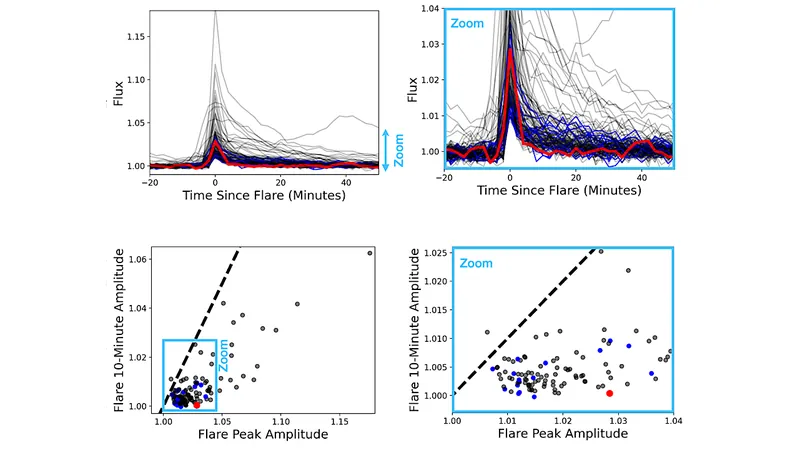
Unveiling the Mysteries of M Dwarfs: Can We Locate Solar Flares Through Exoplanet Transits?
2025-01-11
Author: Jacob
Understanding M Dwarfs and Their Unique Characteristics
M dwarfs, also known as red dwarfs, proudly hold the title of the most prevalent stars in our galaxy. They boast impressive lifespans and have a high frequency of rocky planets, often residing within close habitable zones. However, beneath this stellar façade lies a dark truth: these seemingly placid stars often exhibit intense activity characterized by frequent flares and coronal mass ejections (CMEs). This stellar tumult can pose a significant threat to the atmospheres of nearby exoplanets, unleashing radiation and high-energy particles that can lead to atmospheric erosion, ultimately jeopardizing potential habitability.
The Importance of Flaring Behavior in M Dwarfs
Understanding the behavior of these stellar flares is crucial. The latitude at which these flares occur plays a pivotal role in determining the space weather that exoplanets endure. Particularly, flares originating from the equator can result in substantial atmospheric loss due to high-energy particle bombardment. Despite the importance of this information, our knowledge about the flaring latitudes of M dwarfs remains surprisingly limited.
A New Approach: Flare Occultations
To address this gap, researchers are now harnessing an innovative approach—flare occultations. By utilizing optical photometry, they aim to pinpoint the latitudes of these dangerous flares. The technique involves monitoring a planet as it transits in front of a flare. The timing and geometry of this transit can provide critical data to infer the flare's latitude and longitude, an essential step in understanding the hazardous environment around these stars.
Exciting Predictions and Future Observations
Excitingly, initial predictions suggest that there may be between 3 to 22 detectable flare occultations available using data from the Transiting Exoplanet Survey Satellite (TESS). Most of these events are expected to emerge from observations of eclipsing binaries, which are systems where two stars orbit each other closely enough to cause periodic eclipses.
A Promising Candidate: CM Draconis
To showcase the potential of this technique, researchers have conducted an analysis on a promising candidate flare occultation event associated with the eclipsing binary CM Draconis. This groundbreaking study not only pushes the boundaries of our astronomical knowledge but also opens a door to a better understanding of the dynamic interplay between stars and their surrounding planets.
Conclusion: The Quest for Habitability in the Universe
As we delve deeper into the fascinating world of M dwarfs and their flares, we take a step closer to answering the ultimate question: Can these tumultuous stars sustain life on their planets, or do their violent outbursts spell doom for any potential inhabitants? Stay tuned as we continue to uncover the secrets of the universe, one flare at a time!



 Brasil (PT)
Brasil (PT)
 Canada (EN)
Canada (EN)
 Chile (ES)
Chile (ES)
 Česko (CS)
Česko (CS)
 대한민국 (KO)
대한민국 (KO)
 España (ES)
España (ES)
 France (FR)
France (FR)
 Hong Kong (EN)
Hong Kong (EN)
 Italia (IT)
Italia (IT)
 日本 (JA)
日本 (JA)
 Magyarország (HU)
Magyarország (HU)
 Norge (NO)
Norge (NO)
 Polska (PL)
Polska (PL)
 Schweiz (DE)
Schweiz (DE)
 Singapore (EN)
Singapore (EN)
 Sverige (SV)
Sverige (SV)
 Suomi (FI)
Suomi (FI)
 Türkiye (TR)
Türkiye (TR)
 الإمارات العربية المتحدة (AR)
الإمارات العربية المتحدة (AR)